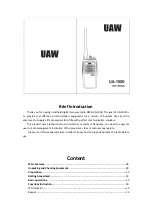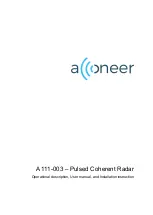
SD-225 User’s Guide
8
©
2006, Midland Radio Corporation
Radio Connections
Connection Overview
The SD-225 features two standard interfaces. The data interface
is used for connection to external modems and provides flat,
unfiltered input and output. The audio interface is used for voice
and some voiceband (300 – 3000 Hz) signaling applications.
If the internal modem option is installed, the data
interface may be configured for direct asynchronous
RS232 data input and output. PTT and Busy may also
be configured for RS232 levels. More information using
the internal modem is available in the modem manual.
Once the interface type is selected, the appropriate connections
may be chosen based on the information given below.
Power Connection
The SD-225 needs a stable 12V DC power source, capable of
supplying at least 2 amps of current. The power connections
should be made to DB9 pins 4 (-) and 5 (+).
The nominal input voltage for the SD-225 is 12 Vdc, but
it is capable of operating in a 9-18 Vdc range.
PTT Connection
A connection to the PTT input, DB9 pin 3, is required to put the
SD-225 into transmit mode. Switching the PTT input to 0V will
initiate transmit mode. With the internal modem option, the PTT
input may be changed to RS232 level.
Busy Connection
A connection may be made to the BUSY_DET output, DB9 pin 6,
which indicates the receive status of the SD-225. Pin 6 is
no5Vdc and switches to 0V when a signal exceeding the
programmed squelch threshold is received. If CTCSS/DCS is
programmed on the channel, the CTCSS/DCS must also be


































